November 21-28, 2002
"Tower Site" Does Dallas, part IV
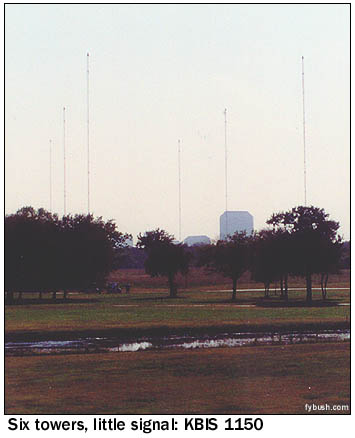 At the end of last week's installment, your intrepid
tower hunters had finished up their morning in Fort Worth, gorged
themselves on good Mexican food and were rapidly headed back
towards Dallas - but with a few more interesting stops on the
way. At the end of last week's installment, your intrepid
tower hunters had finished up their morning in Fort Worth, gorged
themselves on good Mexican food and were rapidly headed back
towards Dallas - but with a few more interesting stops on the
way.
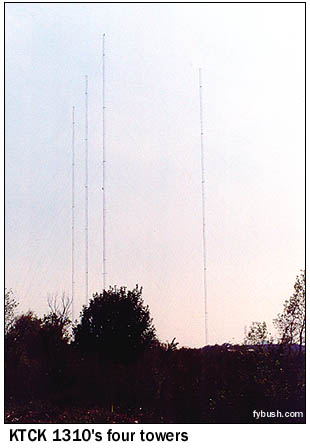 Between Fort Worth
and Dallas lies Irving, home to the Dallas Cowboys - and to the
transmitter of one of Big D's least impressive AM signals. Between Fort Worth
and Dallas lies Irving, home to the Dallas Cowboys - and to the
transmitter of one of Big D's least impressive AM signals.
The 1150 signal, licensed to Highland Park, was historically
KVIL(AM), sister to the very successful adult contemporary FM
on 103.7.
It was a latecomer to the air (1960), and was shoehorned in,
running just 500 watts into these six towers near a golf course
on Royal Lane during the day, and signing off at sunset. (Later,
it would get six watts at night, though it wasn't clear that
they were actually using any night power during our visit.)
In any event, after some 34 years as KVIL (and a quick stint
as KVIX in the mid-80s), 1150 became standards KDMM in the mid-nineties,
then KBIS doing business talk. Today, the business talk is gone
and KBIS is doing leased-time ethnic - at least if you're in
the corner of the market (northern Dallas County, essentially)
that can hear it.
Head north from KBIS through Farmers Branch to the North Lake
area, and just south of Belt Line Road and west of I-35E you'll
encounter the four towers of KTCK (1310). This site is a relatively
recent one, but the station isn't; as WRR, it was owned by the
City of Dallas as early as 1921. The city sold WRR(AM) in 1978,
keeping the FM side (which still does classical music and Dallas
City Council meetings), and the new owners changed the calls
to KAAM (matching KAFM 92.5, its new sister station) and moved
the transmitter from White Rock Lake, southeast of downtown,
to this site, where 1310 throws an impressive signal over Dallas
(though it misses the fast-growing Denton area after dark - but
we'll get back to that.)
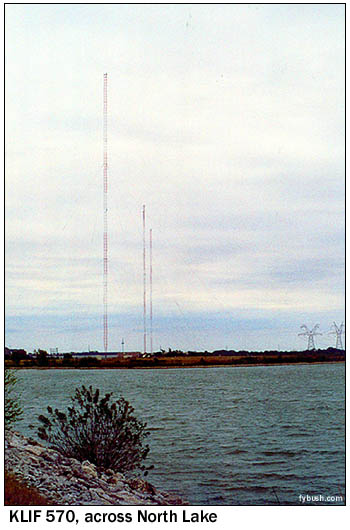 The standards of
KAAM gave way to sports as KTCK ("the Ticket") in January
1994, and that's what they're still doing to this day. The standards of
KAAM gave way to sports as KTCK ("the Ticket") in January
1994, and that's what they're still doing to this day.
A couple of miles to the west of 1310, Belt Line bends south
at the intersection with Denton Tap Road, and right there at
the corner (actually reached via a small service road) are the
three towers of KLIF (570), one of the very best regional-channel
signals in America.
If you've been paying attention to the earlier segments of
this story, you know by now that the 570 signal is the old WFAA
radio, descendant of that unusual WFAA/WBAP shared-time operation
on both 570 and 820. This site came into use in the late sixties,
when the original 570/820 site just a bit to the southwest in
Grapevine was condemned for the construction of the new Dallas/Fort
Worth International Airport.
When it first came into service, I'm told, there were four
towers here: WBAP 820 at the northern end of the site, then the
three 570 sticks to the south. Today, WBAP has moved over to
Tarrant County and 570 stands pretty much alone here. Two of
the towers are closely spaced; to get the third in frame requires
a view from the southern end of North Lake. (And getting that
view required parking across Belt Line Road and running across
traffic to the other side, whereupon your overly-intrepid editor
tripped on a high curb, gouging his hand and cracking the filter
on his lens - ah, the lengths we'll go to for tower pictures!)
In any event, WFAA radio lasted just 13 years on 570 once
the WBAP share-time deal ended. In 1983, in a last gasp of AM
music radio, 570 became classic rock KRQX - in AM stereo, even
- for the last four years of Belo Corp. ownership before it was
sold in 1987. Then came oldies as KLDD and a year as KKWM, simulcasting
soft AC from sister KKWM-FM (97.9), and then the station
was sold to Susquehanna to become the new home of KLIF, the heritage
calls relocated from their home at 1190. And for 12 years now,
KLIF 570 has been doing talk down there at the bottom of the
dial.
(One more site visited but not shown here is KMPX, the Decatur-licensed
channel 29 signal, on a fairly short tower on Northwest Expressway
in Irving, shared with translator K213BP on 90.5.)
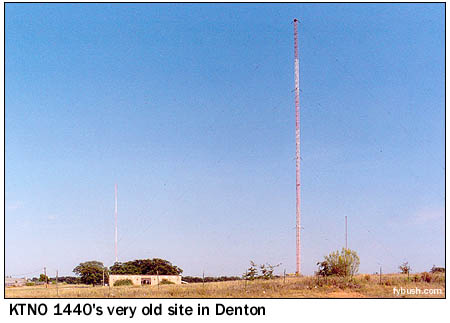 And after two big
days in Dallas and Tarrant counties, we're headed north to see
what's happening in the fast-growing northern fringe of the market.
We rejoin John Callarman, one of the previous day's travel companions,
in Denton, some 30 miles north of Dallas, for a couple of hours'
exploration of the sticks, both old and new, on his home turf. And after two big
days in Dallas and Tarrant counties, we're headed north to see
what's happening in the fast-growing northern fringe of the market.
We rejoin John Callarman, one of the previous day's travel companions,
in Denton, some 30 miles north of Dallas, for a couple of hours'
exploration of the sticks, both old and new, on his home turf.
First up is the old KDNT (1440 Denton), whose site off Teasley
Lane (the street sign says "Mel Wheeler Drive," after
the longtime owner) has seen better days. It's now Tejano KTNO,
the old studio building is vacant and the three towers are badly
in need of maintenance. They may never get it; 1440 holds a construction
permit to move to University Park (one of the "Park Cities"
in wealthy North Dallas) and relocate to the 1040 site on Dallas'
east side, and someday this site will be empty.
From here, we pass through Denton and head up to the north
side of town, where the University of North Texas observatory
sits on a big piece of land on a road called FM 2164. Here we
find the tower of the university's radio station, KNTU (88.1),
which was originally licensed to Denton but changed city of license
to nearby McKinney a few years back. (Why? So that a McKinney-licensed
FM on 106.9 could relocate, clearing the way for a big move-in
that allowed 106.5 in Muenster to move to 106.7. This will make
sense in a minute; hang tight!)
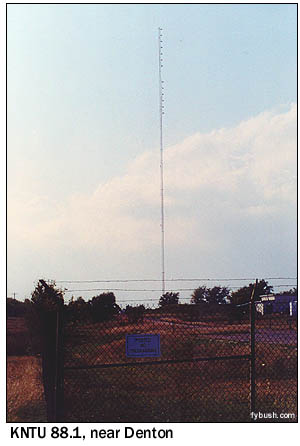 KNTU still signs
off from midnight until 6 daily; when it is on the air, it's
playing a nice selection of jazz, with a good signal into the
northern parts of Dallas and vicinity. KNTU still signs
off from midnight until 6 daily; when it is on the air, it's
playing a nice selection of jazz, with a good signal into the
northern parts of Dallas and vicinity.
(Oh, by the way: the calls came from UNT's earlier identity
as North Texas State University. Would you have renamed
them when the acronym changed?)
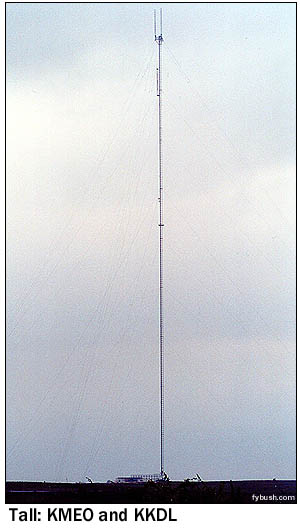 A couple of miles
to the northeast is the very tall, but otherwise unexciting,
tower of KDXX (107.9 Lewisville), one of the many FM rimshots
that dot the terrain of these counties north of Dallas. This
one used to be licensed to Gainesville, way out to the north
of Dallas, but moved in as part of a chess game that relocated
another 107.9 from Corsicana, south of Dallas, way down to Robinson,
in the Waco market. A couple of miles
to the northeast is the very tall, but otherwise unexciting,
tower of KDXX (107.9 Lewisville), one of the many FM rimshots
that dot the terrain of these counties north of Dallas. This
one used to be licensed to Gainesville, way out to the north
of Dallas, but moved in as part of a chess game that relocated
another 107.9 from Corsicana, south of Dallas, way down to Robinson,
in the Waco market.
Moving east, we make a quick stop just shy of the Denton/Cooke
county line at the short tower of KTDK (104.1 Sanger), which
relays the "Ticket" programming from KTCK to this area
with 11 kW of glorious mono. (KTCK also supplements its northern
coverage with KTBK 1700 in Sherman-Denison, an area that lost
literally all its local FMs and most of its AMs to Dallas move-ins
over the last decade or so.)
And then, another ten miles or so to the west where Wise,
Montague and Cooke counties all come together (about 35 miles
north of Fort Worth and a good 60 miles from the Cedar Hill TV/FM
site), we find the tallest of the rimshot towers. At 2000 feet,
this one can be seen from miles away, even in the suddenly cloudy
conditions we've encountered. This monster is home to KMEO (96.7
Flower Mound), a former Sherman station now serving Dallas/Fort
Worth as part of the ABC family, playing soft AC as "Memories
96.7"; KKDL (106.7 Muenster), the former 106.5 that's now
playing dance music for the Metroplex; and construction permits
for KZMP (101.7 Azle), another Denison/Sherman move-in that's
now on another tower nearby - and for KICM (93.7), which is in
the process of moving all the way from Healdton, Oklahoma to
John Callarman's hometown of Krum, Texas.
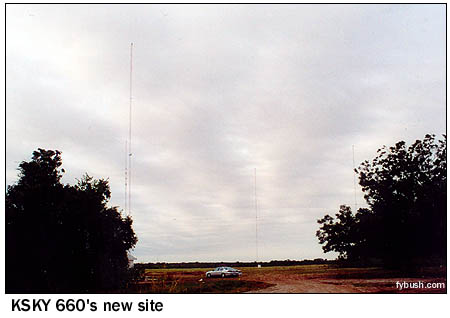 Off in the distance,
we can make out the towers of still more move-ins: KHCK (99.1
Denton), one of the earliest signals to target the Metroplex
from up north, as well as newcomers KRNB (105.7 Decatur) and
religious KDKR (91.3 Decatur). (The very first Denton signal
to target Dallas, the 106.1 now known as KHKS, had the advantage
of being able to relocate all the way down to Cedar Hill; the
other early FM rimshot, the 94.5 signal now known as KSOC, shares
a site east of here with fellow move-ins KWRD 100.7, KESN 103.3
and KTCY 104.9. It's a crowded dial!) Off in the distance,
we can make out the towers of still more move-ins: KHCK (99.1
Denton), one of the earliest signals to target the Metroplex
from up north, as well as newcomers KRNB (105.7 Decatur) and
religious KDKR (91.3 Decatur). (The very first Denton signal
to target Dallas, the 106.1 now known as KHKS, had the advantage
of being able to relocate all the way down to Cedar Hill; the
other early FM rimshot, the 94.5 signal now known as KSOC, shares
a site east of here with fellow move-ins KWRD 100.7, KESN 103.3
and KTCY 104.9. It's a crowded dial!)
We start the next morning in the same vicinity, along I-35E
heading towards Denton, with a stop at the brand new four-tower
site of KSKY (660) along Huffness Road near Highway 121 east
of Lewisville. KSKY will soon move here from its old South Dallas
site, sending 20 kilowatts by day into these fast-growing areas.
We part ways with Garrett after this, as he heads out from
DFW airport to return to Boston, and the next few days bring
only a handful of final sites in between other business.
 In our first
installment, we showed you the "Communications Center"
studios of WFAA-TV (Channel 8) in the dark; now we see them in
daylight, and it makes for an interesting comparison with the
engraving shown at right, which comes from the 1961-62 Broadcasting
Yearbook, when the building on Young Street in downtown Dallas
was brand new. WFAA still sits next to the Dallas Morning
News on Young, but there's a security gate between the two
buildings in our more cautious era - not to mention a new second
story on the front of the channel 8 building, home to an expanded
WFAA-TV newsroom. In our first
installment, we showed you the "Communications Center"
studios of WFAA-TV (Channel 8) in the dark; now we see them in
daylight, and it makes for an interesting comparison with the
engraving shown at right, which comes from the 1961-62 Broadcasting
Yearbook, when the building on Young Street in downtown Dallas
was brand new. WFAA still sits next to the Dallas Morning
News on Young, but there's a security gate between the two
buildings in our more cautious era - not to mention a new second
story on the front of the channel 8 building, home to an expanded
WFAA-TV newsroom.
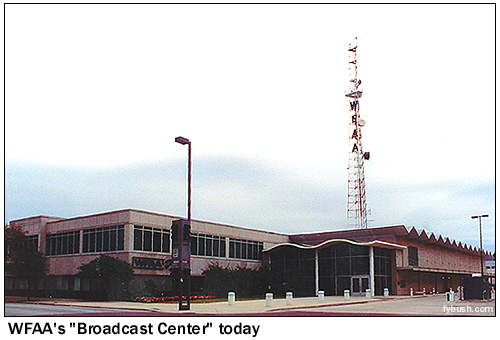 The basic view remains
unchanged, though, and it's still an awfully impressive facility. The basic view remains
unchanged, though, and it's still an awfully impressive facility.
A few blocks away from here, of course, is the infamous Grassy
Knoll, Dealey Plaza, the Book Depository and all those other
reminders of that terrible day 39 years ago this week; we had
a chance to visit the Sixth Floor Museum, and it's an interesting
experience indeed.
From there, it's only a few blocks to 400 North Griffin Street,
the longtime home of channel 4 in Dallas, dating all the way
back to its days as KRLD-TV. This is where Dan Rather was based
when he covered the Kennedy assassination - but today channel
4 doesn't even carry Rather's nightly newscast, having switched
from CBS to Fox in 1995 during the big Fox/New World affiliation
shuffle.
In the meantime, of course, channel 4 had changed from KRLD-TV
to KDFW (the KRLD calls stayed with the radio side, which split
off in 1974), the calls it still uses today as "Fox 4."
And today there's a second station sharing the building; Fox
also owns independent KDFI (Channel 27), which carries most of
the local telecasts of Rangers baseball and Stars hockey.
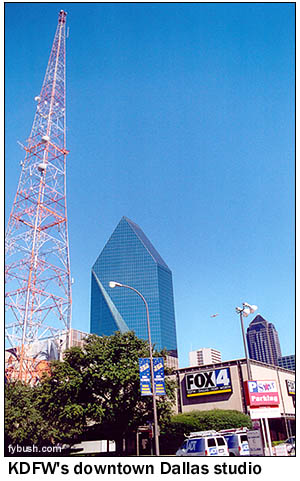 The tower next to
the studio building is still used for STLs and ENG; I believe
it's the original channel 4 tower from the days before KRLD-TV
and WFAA-TV built the Cedar Hill site in 1955. The tower next to
the studio building is still used for STLs and ENG; I believe
it's the original channel 4 tower from the days before KRLD-TV
and WFAA-TV built the Cedar Hill site in 1955.
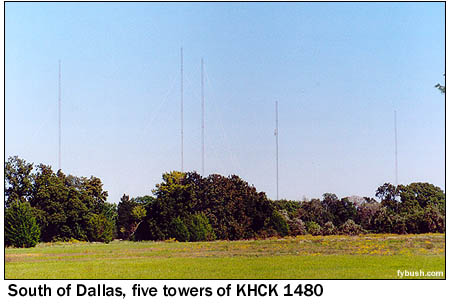
And if you've been paying careful attention to our story,
you'll know that there's just one more Dallas AM site left on
the list, the 1480 signal that was long known as KBOX. (Actually,
1480 began in 1953 as KGKO, borrowing the calls of the long-ago
Wichita Falls station on 570 that became half of the WFAA-WBAP
sharetime, but that's another story). KBOX challenged KLIF's
top 40 supremacy for many years, broadcasting from a site at
9900 North McCree Road that no longer exists. In later years,
as KMEZ, business news KDBN, easy listening KCMZ, Spanish KMRT
and under today's calls of KHCK, it's used this five-tower site
near Hutchins, south of Dallas where I-45 crosses I-20. Today's
format on 1480 is Tejano "Kick FM," simulcasting KHCK-FM
(99.1) up in Denton. And since 99.1 doesn't go south very well,
while 1480 doesn't really get north at all, it all works out,
more or less.
(What doesn't work out so well is the speeding ticket we get
heading back up north on I-635, but that too is another story...)
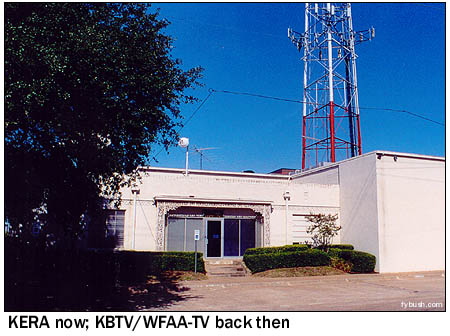 And we leave you
with one final site, appropriately enough a very old one. And we leave you
with one final site, appropriately enough a very old one.
At 3000 Harry Hines Boulevard, just north of downtown, sits
the rambling studio complex of public broadcaster KERA, home
now to KERA-FM (90.1), KERA-TV (Channel 13) and KDTN (Channel
2).
Look very carefully at the part of the building on the corner
of Wolf Street and you can see that it's significantly older
than the rest of the complex. It dates back, in fact, to 1949,
when this building and the tower next door were the first transmitter
site of Dallas' first TV station, KBTV (Channel 8). The Harry
Hines site remained home to channel 8 when it became WFAA-TV
the next year, and the site remained WFAA's home until Cedar
Hill went up in 1955.
It was conveniently available when KERA started operation
in 1960 (WFAA's studios having just moved downtown to Young Street),
and the public broadcaster has called it home ever since. And
here's an irony to consider: WFAA's FM station, now known as
KBFB and operating on 97.9, can trace its history all the way
back to 1947...when it signed on the air at 94.3 on the dial
- as "KERA"!
And with that we bid adieu to the Metroplex, with fond hopes
of returning next fall when the National
Radio Club celebrates its seventieth anniversary there. As
for Site of the Week, we'll be back in seven days with a special
Thanksgiving treat...stay tuned!
Special thanks to WFAA transmitter
engineer Don Guemmer, Wally Wawro, John Callarman, Chris Huff
of KSCS, Wayne Kube at Belo corporate, and KRLD's Tyler Cox!
Also be sure to check out Mike Shannon's excellent Dallas radio
history pages at www.knus99.com,
and Steve Eberhart's amazingly comprehensive History
of KLIF site...
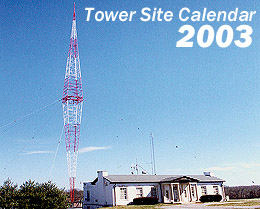 Want to see more neat sticks all year
round? Nashville's WSM (at left) is one of the more than
a dozen Tower Site images featured in the 2003 Tower Site Calendar,
coming this fall from Tower Site of the Week and fybush.com. Want to see more neat sticks all year
round? Nashville's WSM (at left) is one of the more than
a dozen Tower Site images featured in the 2003 Tower Site Calendar,
coming this fall from Tower Site of the Week and fybush.com.
If you liked last year's edition, you'll love this one: higher-quality
images (in addition to WSM, this year's edition includes Providence's
WHJJ; Mount Mansfield, Vermont; Buffalo's WBEN; KOMA in Oklahoma
City; WTIC, Hartford; Brookmans Park, England; WPAT, Paterson;
Four Times Square, New York; WIBC in Indianapolis; WWVA in Wheeling,
W.V.; WGN Chicago and more), more dates in radio history, a convenient
hole for hanging - and we'll even make sure all the dates fall
on the right days!
This year's calendar will go to press very soon, and if you
order now, you'll have yours in hand by late November, in plenty
of time for the holidays. And this year, you can order with your
Visa, MasterCard, Discover or American Express by using the handy
link below!
Better yet, here's an incentive to make your 2003 NERW/Site
of the Week subscription pledge a little early: support NERW/fybush.com
at the $60 level or higher, and you'll get this lovely calendar
for free! How can you go wrong? (Click here
to visit our Support page, where you can make your NERW contribution
with a major credit card...)
You can also order by mail; just send a check for $16
per calendar (NYS residents add 8% sales tax), shipping included,
to Scott Fybush, 92 Bonnie Brae Ave., Rochester
NY 14618.
Thanks for your support!
|